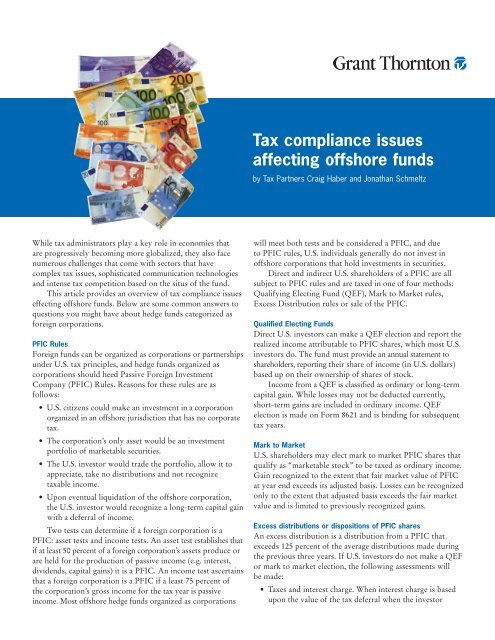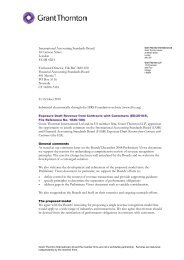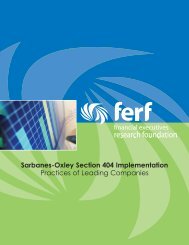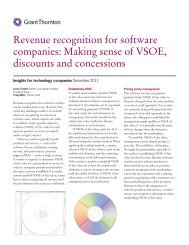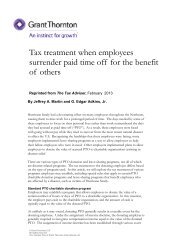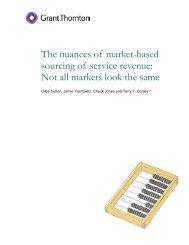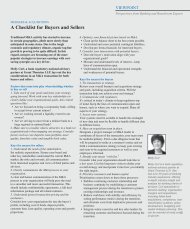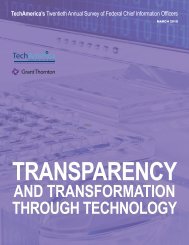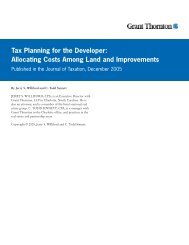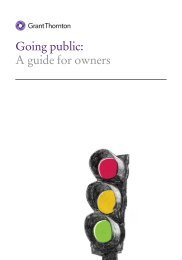Tax compliance issues affecting offshore funds - Grant Thornton
Tax compliance issues affecting offshore funds - Grant Thornton
Tax compliance issues affecting offshore funds - Grant Thornton
You also want an ePaper? Increase the reach of your titles
YUMPU automatically turns print PDFs into web optimized ePapers that Google loves.
<strong>Tax</strong> <strong>compliance</strong> <strong>issues</strong><strong>affecting</strong> <strong>offshore</strong> <strong>funds</strong>by <strong>Tax</strong> Partners Craig Haber and Jonathan SchmeltzWhile tax administrators play a key role in economies thatare progressively becoming more globalized, they also facenumerous challenges that come with sectors that havecomplex tax <strong>issues</strong>, sophisticated communication technologiesand intense tax competition based on the situs of the fund.This article provides an overview of tax <strong>compliance</strong> <strong>issues</strong>effecting <strong>offshore</strong> <strong>funds</strong>. Below are some common answers toquestions you might have about hedge <strong>funds</strong> categorized asforeign corporations.PFIC RulesForeign <strong>funds</strong> can be organized as corporations or partnershipsunder U.S. tax principles, and hedge <strong>funds</strong> organized ascorporations should heed Passive Foreign InvestmentCompany (PFIC) Rules. Reasons for these rules are asfollows:• U.S. citizens could make an investment in a corporationorganized in an <strong>offshore</strong> jurisdiction that has no corporatetax.• The corporation’s only asset would be an investmentportfolio of marketable securities.• The U.S. investor would trade the portfolio, allow it toappreciate, take no distributions and not recognizetaxable income.• Upon eventual liquidation of the <strong>offshore</strong> corporation,the U.S. investor would recognize a long-term capital gainwith a deferral of income.Two tests can determine if a foreign corporation is aPFIC: asset tests and income tests. An asset test establishes thatif at least 50 percent of a foreign corporation’s assets produce orare held for the production of passive income (e.g. interest,dividends, capital gains) it is a PFIC. An income test ascertainsthat a foreign corporation is a PFIC if a least 75 percent ofthe corporation’s gross income for the tax year is passiveincome. Most <strong>offshore</strong> hedge <strong>funds</strong> organized as corporationswill meet both tests and be considered a PFIC, and dueto PFIC rules, U.S. individuals generally do not invest in<strong>offshore</strong> corporations that hold investments in securities.Direct and indirect U.S. shareholders of a PFIC are allsubject to PFIC rules and are taxed in one of four methods:Qualifying Electing Fund (QEF), Mark to Market rules,Excess Distribution rules or sale of the PFIC.Qualified Electing FundsDirect U.S. investors can make a QEF election and report therealized income attributable to PFIC shares, which most U.S.investors do. The fund must provide an annual statement toshareholders, reporting their share of income (in U.S. dollars)based up on their ownership of shares of stock.Income from a QEF is classified as ordinary or long-termcapital gain. While losses may not be deducted currently,short-term gains are included in ordinary income. QEFelection is made on Form 8621 and is binding for subsequenttax years.Mark to MarketU.S. shareholders may elect mark to market PFIC shares thatqualify as “marketable stock” to be taxed as ordinary income.Gain recognized to the extent that fair market value of PFICat year end exceeds its adjusted basis. Losses can be recognizedonly to the extent that adjusted basis exceeds the fair marketvalue and is limited to previously recognized gains.Excess distributions or dispositions of PFIC sharesAn excess distribution is a distribution from a PFIC thatexceeds 125 percent of the average distributions made duringthe previous three years. If U.S. investors do not make a QEFor mark to market election, the following assessments willbe made:• <strong>Tax</strong>es and interest charge. When interest charge is basedupon the value of the tax deferral when the investor
2disposes of the stock or receives excess distribution.The income is currently taxed as ordinary subject toshareholders’ effective tax rate.• Rules do not apply to tax-exempt investors holding sharesin a PFIC.• Once a PFIC, always a PFIC.• Most foreign countries do not have tax rules similarto U.S. rules, so there are no negative tax consequencesfor foreign investors.Reporting requirementsU.S. taxpayers with ownership in <strong>offshore</strong> corporations aresubject to reporting requirements. These include tax returnrequirements, which dictate that <strong>offshore</strong> hedge <strong>funds</strong> treatedas foreign corporations for U.S. tax purposes do no have to filea U.S. corporate tax return as long as their U.S. tax liability issatisfied through withholding.To report a transfer of property to a foreign corporation,U.S. taxpayers should use Form 926. Immediately after thetransfer, the taxpayer holds directly or indirectly 10 percent ofthe voting power or value of the foreign corporation. If thetransferor is a partnership, the domestic partners of thepartnership are required to file.Form 5471 (“Information Return of U.S. Persons withRespect to Certain Foreign Corporation”) must be filedby U.S. persons (which include an individual, partnership,corporation, estate and trust) who are officers, directors orshareholders in <strong>offshore</strong> corporate hedge <strong>funds</strong>, U.S. personsthat acquire a 10 percent or greater interest in an <strong>offshore</strong>corporate hedge fund or U.S. persons who own more thana 50 percent interest in the <strong>offshore</strong> corporate hedge fund.This form requires a balance sheet and income statementof the foreign corporation and the shareholder’s ownershippercentage.Benefits of setting up an <strong>offshore</strong> partnershipAn <strong>offshore</strong> partnership may provide the manager with certaintax advantages, and the incentive fee may include qualifieddividends, long-term capital gains and unrealized income.Furthermore, the incentive fee may not be subjected toNew York City Unincorporated Business <strong>Tax</strong> (UBT) or selfemploymenttax. A foreign partnership is, however, requiredto file a partnership return for a taxable year if the partnershipis engaged in a U.S. trade or business (trading securitiesfor your own account is not considered to be a U.S. tradeor business).What are the tax return filing requirements for an <strong>offshore</strong>hedge fund structures as a partnership meeting the followingthree conditions?• Not engaged in a U.S. trade or business,• Not classified as “a withholding foreign partnership,”• U.S. Federal tax liability (if any) of the foreign partnershas fully satisfied the withholding of tax at source.If there are no U.S. partners, no U.S. return is required,but if there are U.S. partners, investors must file a U.S.partnership tax return and attach only Schedules K-1 reportingincome allocable to U.S. partners.Transfers to a foreign partnershipInformation reporting of investments in foreign partnershipsshould be disclosed on Form 8865. These include acquisitions,dispositions and changes in interest by a U.S. person in aforeign partnership, transfers by a U.S. person to a foreignpartnership, and interests in a controlled foreign partnership.Several tax return requirements for foreign partnershipsexist. A foreign partnership that has no income that is effectivelyconnected with the conduct of a trade or business within theU.S. but has gross income derived from U.S. sources will beexempt from filing a U.S. tax return if:• No U.S. person has a direct or indirect interest in the partnership.• The gross U.S. source income is a Fixed, Determinable,Annual Periodic tenure (FDAP) is and subject towithholding.• Forms 1042 and 1042-S are filled with respect to suchwithholding.• The tax liability of the partnership with respect to suchgross income is fully satisfied by the withholding of taxat source. Craig Haber<strong>Tax</strong> Partner212.624.5280Craig.Haber@gt.comJonathan Schmeltz<strong>Tax</strong> Partner212.624.5281Jonathan.Schmeltz@gt.comThis document supports <strong>Grant</strong> <strong>Thornton</strong> LLP's marketing of professional services, and is not written tax advice directed atthe particular facts and circumstances of any person. If you are interested in the subject of this document we encourage you tocontact us or an independent tax advisor to discuss the potential application to your particular situation. Nothing herein shallbe construed as imposing a limitation on any person from disclosing the tax treatment or tax structure of any matter addressedherein. To the extent this document may be considered to contain written tax advice, any written advice contained in, forwardedwith, or attached to this document is not intended by <strong>Grant</strong> <strong>Thornton</strong> to be used, and cannot be used, by any person for thepurpose of avoiding penalties that may be imposed under the Internal Revenue Code.


